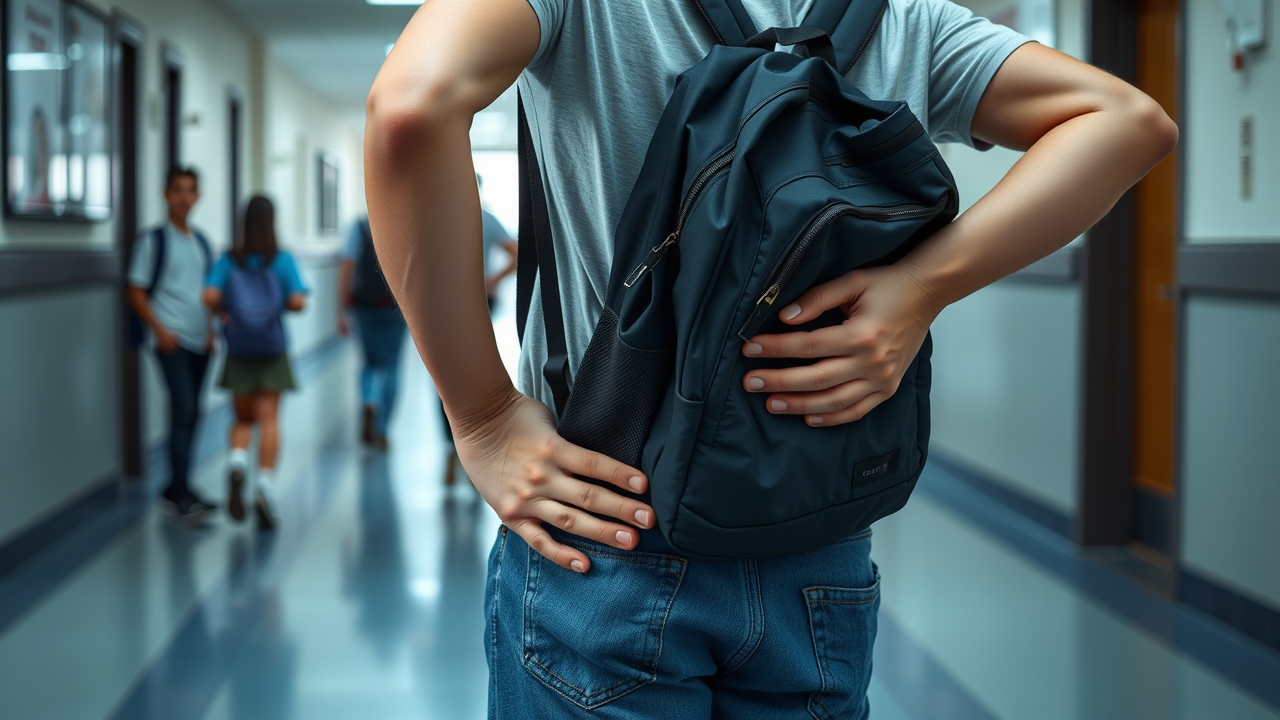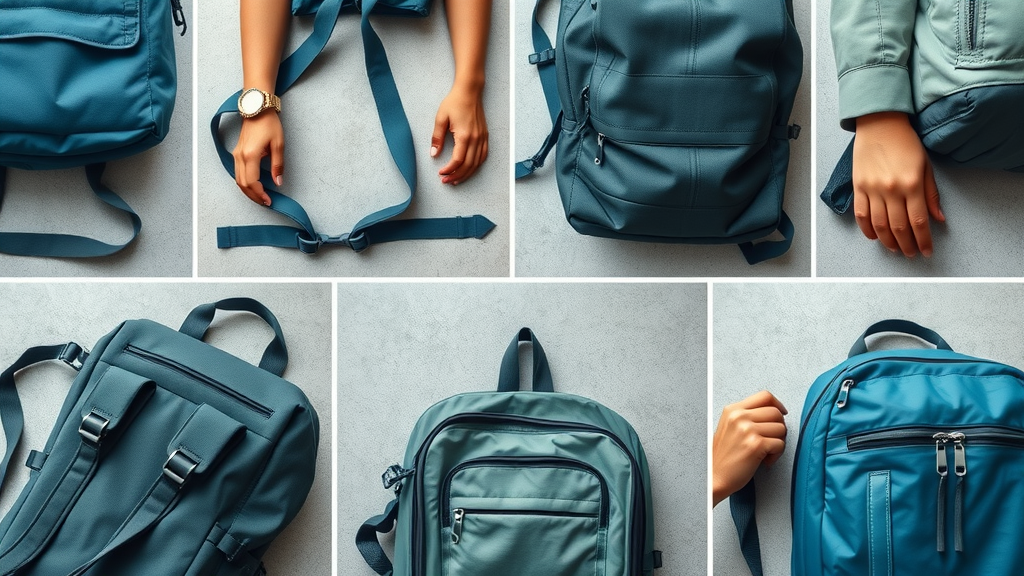Are you sure your child’s backpack is helping, not harming? Discover common hazards threatening student safety and learn simple, expert-backed tips to protect their health and comfort this school year. With the rush of back to school, don’t let an overlooked backpack detail put your child at risk for pain or injury—find out what to avoid right now.

Why Backpack Safety for Students Matters Every School Year
Every school year, millions of children head to class carrying backpacks brimming with school supplies, books, and technology. While backpacks are meant to be a convenient tool for students, an overloaded or improperly fitted bag can turn a normal school day into the start of chronic pain or even injury.
Experts, including physical therapists and orthopaedic surgeons, warn that the effects of a heavy backpack can do more than cause temporary discomfort—it can have a real impact on a student’s spine, posture, and overall wellness throughout the school year.
The main goal of backpack safety for students is to prevent injury before it starts. Simple steps, such as choosing the right size, packing wisely, and ensuring a proper fit, can keep kids safe in the classroom and on the go. This comprehensive guide will highlight the specific risks, provide actionable solutions, and empower both parents and students to take charge of their health and comfort.
Remember, even small changes can spare your child from developing back pain or other musculoskeletal problems, ensuring a more successful and pain-free school year.

Understanding the Risks: Back Pain and Backpack Safety
One of the most common complaints among students today is back pain, often tied directly to improper backpack use. Carrying a heavy backpack can strain the muscles and joints of the back, shoulders, and neck, leading to discomfort, postural changes, and even chronic problems.
The weight of the backpack, especially when exceeding 10-15% of the child’s body weight, poses a serious risk. Children who lug extra weight daily can experience pain, fatigue, and weakness in the arms or upper back, impacting their concentration and participation in class.
Warning signs of improper use include persistent back pain, tingling or numbness in the arms, and visible postural changes such as slouching or leaning forward. These issues aren’t just physical—a student distracted by pain is less engaged academically. The American Academy of Pediatrics, along with many physical therapists, stresses the importance of backpack safety: a combination of limiting load, proper design, and consistent, correct use.
Take time each week to check in with your child. If your child is experiencing pain or visible discomfort, it may be time to reassess how they're carrying their school supplies and whether they could benefit from an evaluation by a healthcare professional.
The Impact of a Heavy Backpack on Student Health
Carrying a heavy backpack for prolonged periods does more harm than most parents realize. The extra weight can pull a child’s body backward, prompting them to lean forward at the hips or arch their back, leading to unnatural posture and muscle strain. Over time, this unhealthy compensation may result in problems with the upper back, neck, and even hips. Young bodies are still growing, so continuous stress from heavy loads increases the chances of developing structural issues or chronic pain that could persist into adulthood.
Physical therapists often observe an increase in complaints like shoulder, neck, and back discomfort at the beginning of each school year. These can be directly linked to improper backpack practices, such as over-packing or slinging the bag over just one shoulder. There can also be signs of decreased strength, especially if the child frequently experiences fatigue, difficulty lifting, or weakness in the arms. Experts recommend regular checks to ensure your child’s backpack doesn’t outweigh their comfort or compromise their muscular health.
"As a physical therapist, I see an uptick in back pain cases every school year due to improper backpack use," says Dr. Michelle Tan, DPT.

Common Backpack Hazards Students Face
There are several hazards when it comes to backpack safety for students, but the most concerning are often the easiest to overlook. From excessive weight to incorrect size and poor packing habits, each factor can put your child on the path to pain or injury. Understanding these risks is the first step to creating a safer school routine. Awareness can help parents and students spot warning signs early and adjust before problems escalate. Let's look at specific pitfalls to avoid this school year.
Overloading, poor fit, and unsafe materials or accessories are the leading causes of preventable injuries. Every parent wants to make sure their child is equipped to succeed, but a well-intended “just in case” approach can load kids down with unnecessary gear. Not all backpacks are created equal—improper designs, non-padded straps, and broken zippers also increase the risk of accidents, from tripping to minor lacerations. Staying alert to these dangers makes all the difference.
Overloading: How the Weight of the Backpack Affects Comfort and Safety
The weight of the backpack is the most common hazard affecting backpack safety for students. When kids carry heavy loads exceeding recommended weight guidelines, the risk of back pain and muscular fatigue rises dramatically. According to health organizations, a safe backpack shouldn't weigh more than 10-15% of a child's body weight. For a typical elementary schooler, this means restricting total weight to around 5-7 pounds—often far less than what is currently carried.
Overloaded packs don’t just stress the back; they can contribute to awkward walking patterns, tripping hazards, and even falls. In addition, excess weight encourages students to wear their bags slung low or over one shoulder, increasing postural strain and compressing nerves in the upper back and arms. Helping children regularly lighten their backpack and pack only essentials can go a long way in protecting their muscles and joints throughout the busy school year.
For students who experience persistent discomfort despite these adjustments, it may be helpful to explore additional strategies for managing pain and mobility—such as those discussed in this guide to understanding pain and relief while staying active.
Recommended Backpack Weights by Age Group and Grade
Age/Grade |
Child's Body Weight |
Maximum Backpack Weight |
|---|---|---|
6–8 yrs (Grades 1–3) |
50–60 lbs |
5–7 lbs |
9–11 yrs (Grades 4–5) |
65–85 lbs |
7–12 lbs |
12–14 yrs (Middle School) |
90–120 lbs |
9–18 lbs |
15–18 yrs (High School) |
120–160 lbs |
12–24 lbs |
Incorrect Backpack Fit: Straps, Size, and Rolling Backpack Considerations
A proper backpack fit is crucial. Straps should be wide, padded, and adjustable to distribute weight evenly. A low-hanging backpack can pull students backward, straining the spine and muscles, while unpadded shoulder straps can dig into the skin and restrict circulation.
The backpack’s size should also be proportionate to your child’s frame—not too large or small—ensuring it rests between the shoulders and the middle of the back. Fitting the bag snugly reduces side-to-side swaying, which can lead to awkward walking patterns and muscles and joints strain.
For some students, switching to a rolling backpack might be a necessity—especially for those with medical needs or especially heavy loads (such as school-issued technology). While rolling backpacks help prevent injury by eliminating weight from the back and shoulders, they can also present their own issues, like tripping hazards in crowded corridors. Always weigh the pros and cons based on your child’s needs, and seek advice from a school physical therapist for guidance.

Backpack Safety for Students: Materials and Hazardous Accessories
Another easily overlooked danger comes from inside and outside the bag itself. Materials—such as unsafe plastics or cheap fabrics—can rip, tear, or break, causing sharp edges or sudden spills of contents. Hazardous accessories may include decorative but dangerous features like metal studs, mismatched zipper pulls, or extra-long straps that drag on the ground. Inside, sharp objects like unprotected scissors or protractors, broken pencils, or even loose electronics can poke through weak compartments and increase the risk of minor injuries. Ensuring all school gear is secured safely and that zippers, buckles, and straps are in good condition prevents surprises and discomfort during the school day.
How to Prevent Injury: Best Practices for Backpack Safety for Students
The best way to safeguard your child’s health is to follow proven best practices for backpack safety for students. Small daily habits and smart purchases build the foundation for lifelong comfort and good posture. Focus on selecting the right backpack, packing it properly, and ensuring correct daily use. Involving students in these habits teaches them personal responsibility and helps them recognize when they might be at risk of back pain or other injury.
Parents, teachers, and school health professionals—like physical therapists—can collectively ensure the topic stays in focus during the busy back to school season and beyond. Integrate these tips into your family’s daily routine to prevent injury before it starts.
Selecting the Right Backpack for the School Year
Choosing a backpack is more than picking a design your child likes. Look for two sturdy, padded shoulder straps, a cushioned back, multiple compartments for weight distribution, and a proportional size suited to your child’s height and build. Features such as a waist or chest strap can help further distribute the weight and keep the load stable. A backpack with reinforced seams and quality materials will hold up better—and safer—through rough daily use.

It’s also important to shop for fit, not brand or trend. A backpack should never be wider or longer than your child’s torso and should sit no lower than the small of the back. If your child needs to carry especially heavy loads due to extracurricular activities, consider a rolling backpack or discuss with school staff about minimizing what needs to be carried. Starting the school year with a bag that fits makes every day safer.
"Choose a backpack that’s proportionate to your child’s body and features padded straps to prevent injury," recommends pediatric physical therapist, Lisa Gomez.
How to Properly Pack and Wear a Backpack: Advice from Physical Therapists
A well-packed bag reduces the risk of back pain and helps prevent injury. Place the heaviest items (like textbooks or laptops) closest to the back, so the weight stays near your child’s center of gravity. Distribute other items evenly in compartments to keep the load balanced and minimize shifting during movement. Avoid packing unnecessary objects—teach your child to carry home only what’s needed that day for assignments or activities.
Wearing a backpack the right way is as important as packing it well. Use both straps, adjusted snugly to keep the bag centered between the shoulders and above the waist. Remind your child to avoid slinging a single shoulder strap—all straps should rest comfortably and evenly, never digging into skin or hanging loose. If your child reports back pain, weakness in the arms, or tingling in the fingers, revisit these guidelines and check the weight of the backpack.
Demonstration: Proper Packing and Wearing Techniques for Backpack Safety for Students
When to Consider a Rolling Backpack for Backpack Safety for Students
Sometimes, a rolling backpack is the best choice for a student who regularly carries more than is safe, has a history of back pain, or is recovering from injury. Rolling backpacks eliminate stress on the shoulders and back, making them a smart pick for certain children. However, keep in mind that rolling backpacks may not be allowed in every school due to hall congestion or tripping hazards, and they might not be ideal for stairs or rough outdoor terrain.
Consult with a physical therapist or your school nurse to determine if a rolling backpack is right for your child. For students with ongoing medical needs or who attend larger schools that require carrying books between distant classrooms, this option can make a big difference in daily comfort and injury prevention. Teach your child how to properly maneuver and store the backpack so it doesn’t become a tripping hazard for others.

People Also Ask About Backpack Safety for Students
Is it safe to put a child's name on a backpack?
Answer: It’s safer to put initials inside the backpack to avoid making children an easy target for strangers.
What are 10 safety rules for students?
Answer: Supervise use, avoid overpacking, use both straps, keep the backpack close to the body, avoid running while wearing, never leave it unattended, keep zippers closed, avoid sharp or loose items, check for damages, educate about stranger danger.
Why are backpacks not allowed in classrooms?
Answer: To prevent tripping hazards, fire hazards, and to maintain classroom safety, some schools prohibit backpacks in classrooms.
How much weight can a 7 year old carry?
Answer: Experts recommend a backpack should not exceed 10-15% of a child’s body weight; for a typical 7-year-old, that’s usually 5-7 pounds.

Must-Know Backpack Safety Tips for the School Year
Taking charge of backpack safety for students is about building simple, effective habits. Here’s what physical therapists and safety experts recommend as key tips for this school year:
Always use both straps.
Keep the weight of the backpack under 10-15% of body weight.
Adjust straps for a snug fit.
Choose backpacks with padded straps and backs.
Pack heavier items closer to the back.
Use a rolling backpack as advised by a physical therapist.
Consistent application of these rules can help students of all ages prevent injury and enjoy a healthier, more productive school routine.
Frequently Asked Questions: Backpack Safety for Students
Can improper backpack safety for students cause long-term back pain?
Yes. Repeated use of an overloaded or improperly worn backpack can lead to chronic back pain, postural problems, and weakness in the arms—especially for younger students whose bodies are still growing. Addressing safety before symptoms arise is key to lifelong wellness.
Should students use a rolling backpack or traditional backpack during the school year?
A rolling backpack is a good option for students carrying heavy loads or with certain medical considerations, as it relieves stress on the back and shoulders. However, they are not right for every child or campus. Consult a physical therapist or school health professional if you’re unsure which is best for your child’s needs this school year.
Are there materials to avoid for optimal backpack safety?
Yes. Focusing on durable, lightweight materials and safe, strong components is crucial. Avoid backpacks made from easily ripped plastics and those with unsafe accessories (such as metal spikes or long, loose straps). Check regularly for damage and repair or replace as needed.

Conclusion: Supporting Student Wellness with Smart Backpack Safety Choices
With daily attention to backpack safety for students, families can set the stage for pain-free learning and active, happy students every school year.
Call to Action: Ensure backpack safety for students this school year—review your child’s backpack today and prevent injury before it starts.
As you continue to prioritize your child’s safety and well-being, consider how other aspects of school readiness can further support their health. For a comprehensive approach to back-to-school wellness, including the importance of up-to-date immunizations, explore our resource on why immunizations against measles and whooping cough matter as school starts. Taking these extra steps ensures your student is protected from preventable risks—both inside and outside the classroom.
Sources
American Academy of Pediatrics – https://www.aap.org/en/patient-care/backpack-safety-tip-sheet
American Academy of Orthopaedic Surgeons – https://www.orthoinfo.org/en/staysafe/backpack-safety/
PT&Me Physical Therapy – https://www.ptandme.com/backpack-safety/
Nemours KidsHealth – https://kidshealth.org/en/parents/backpack.html
Ensuring your child’s backpack is safe and comfortable is crucial for their health and well-being. The article “Backpack Safety | Nemours KidsHealth” provides comprehensive guidelines on selecting the right backpack, proper packing techniques, and correct wearing methods to prevent back pain and posture issues. (kidshealth.org)
Additionally, “Kids’ backpack safety tips: How to avoid injury this school year | Doctors Hospital” offers practical advice on weight considerations, choosing the safest backpack, and recognizing warning signs of an overloaded pack. (doctors-hospital.net) By following these expert recommendations, you can help your child avoid common backpack-related hazards and promote a healthier, more comfortable school experience.
 Add Row
Add Row  Add
Add 




Write A Comment